Geology and Mineralogy of Uranium Deposits from Mount Isa, Australia: Implications for Albitite Uranium Deposit Models
Abstract
:1. Introduction
| Deposit | Ore (Mt) | U3O8 (%) | U3O8 (Mlbs) | U3O8 (t) |
|---|---|---|---|---|
| Valhalla | 43.76 | 0.08 | 76.3 | 34,602 |
| Skal | 15.70 | 0.06 | 21.8 | 9,885 |
| Mary Kathleen | 9.20 | 0.12 | 19.6 | 8,891 |
| Odin | 14.00 | 0.06 | 17.6 | 7,964 |
| Bikini | 12.50 | 0.05 | 13.7 | 6,192 |
| Anderson’s Lode | 1.50 | 0.14 | 5.0 | 2,283 |
| Watta | 5.60 | 0.04 | 5.0 | 2,260 |
| Honey Pot | 2.60 | 0.07 | 4.0 | 1,800 |
| Mirrioola | 2.00 | 0.06 | 2.5 | 1,132 |
| Queen’s Gift | 4.40 | 0.02 | 2.4 | 1,080 |
| Duke Batman | 0.80 | 0.12 | 2.3 | 1,053 |
| Slance | 1.05 | 0.05 | 1.1 | 500 |
| Citation/Mighty Glare | 0.80 | 0.04 | 0.7 | 320 |
| Eldorado North | 0.37 | 0.05 | 0.4 | 170 |
| Warawai | 0.40 | 0.04 | 0.3 | 134 |
| Elaine Dorothy | 0.08 | 0.03 | 0.1 | 25 |
| Total | 172.6 | 78,291 |
2. Geology of the Mount Isa Uranium District
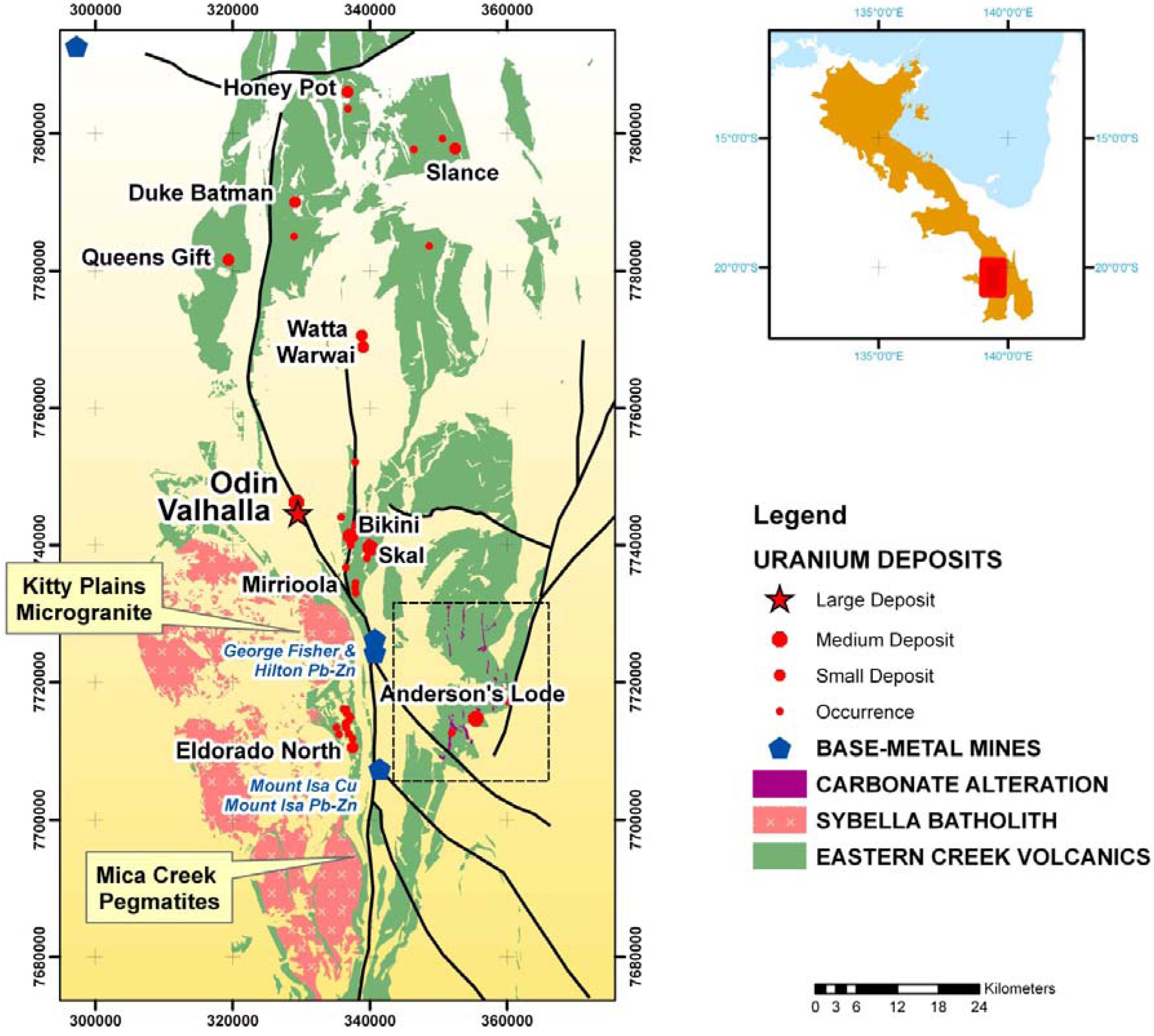
3. Geology of the Deposits
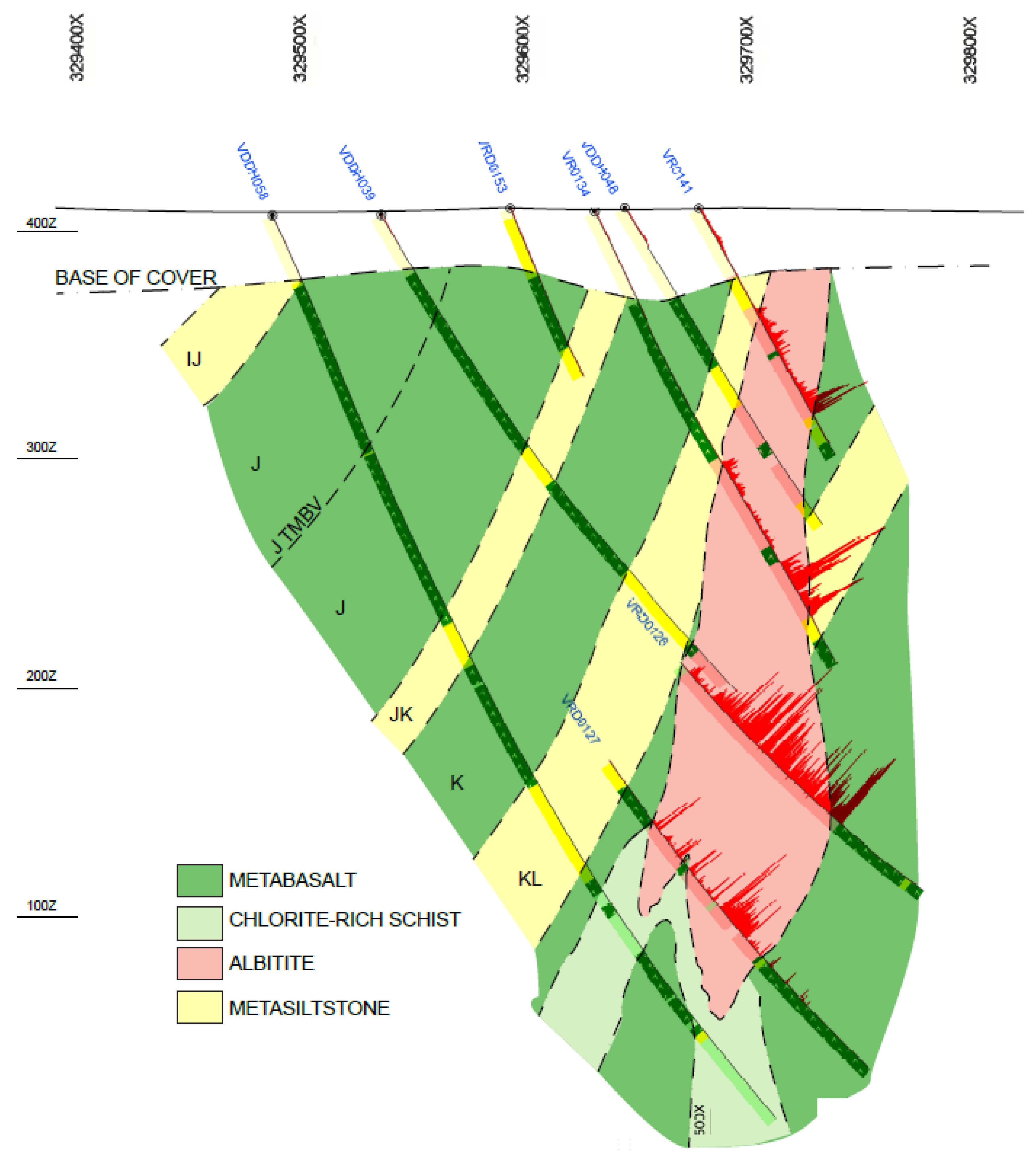
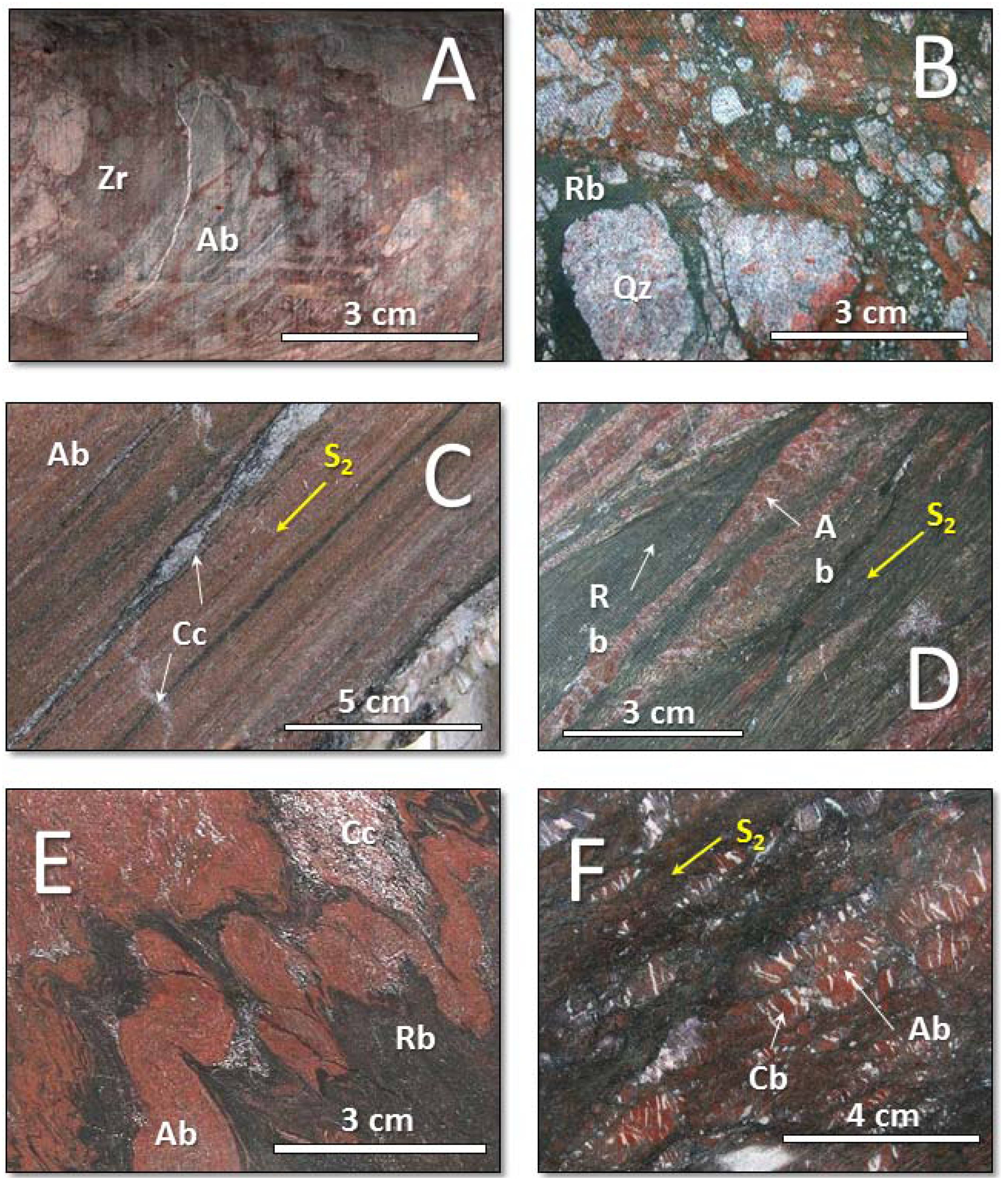
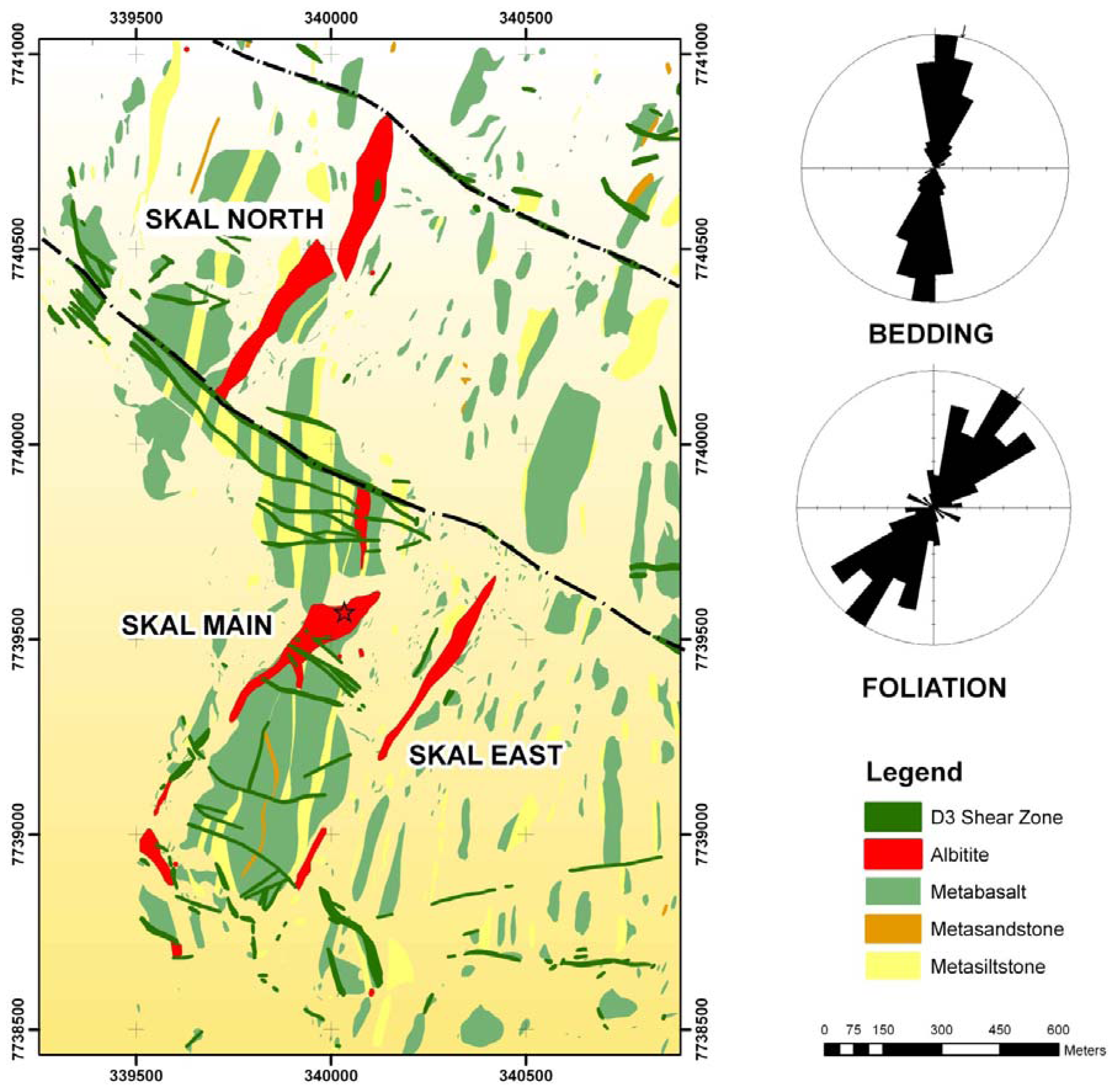
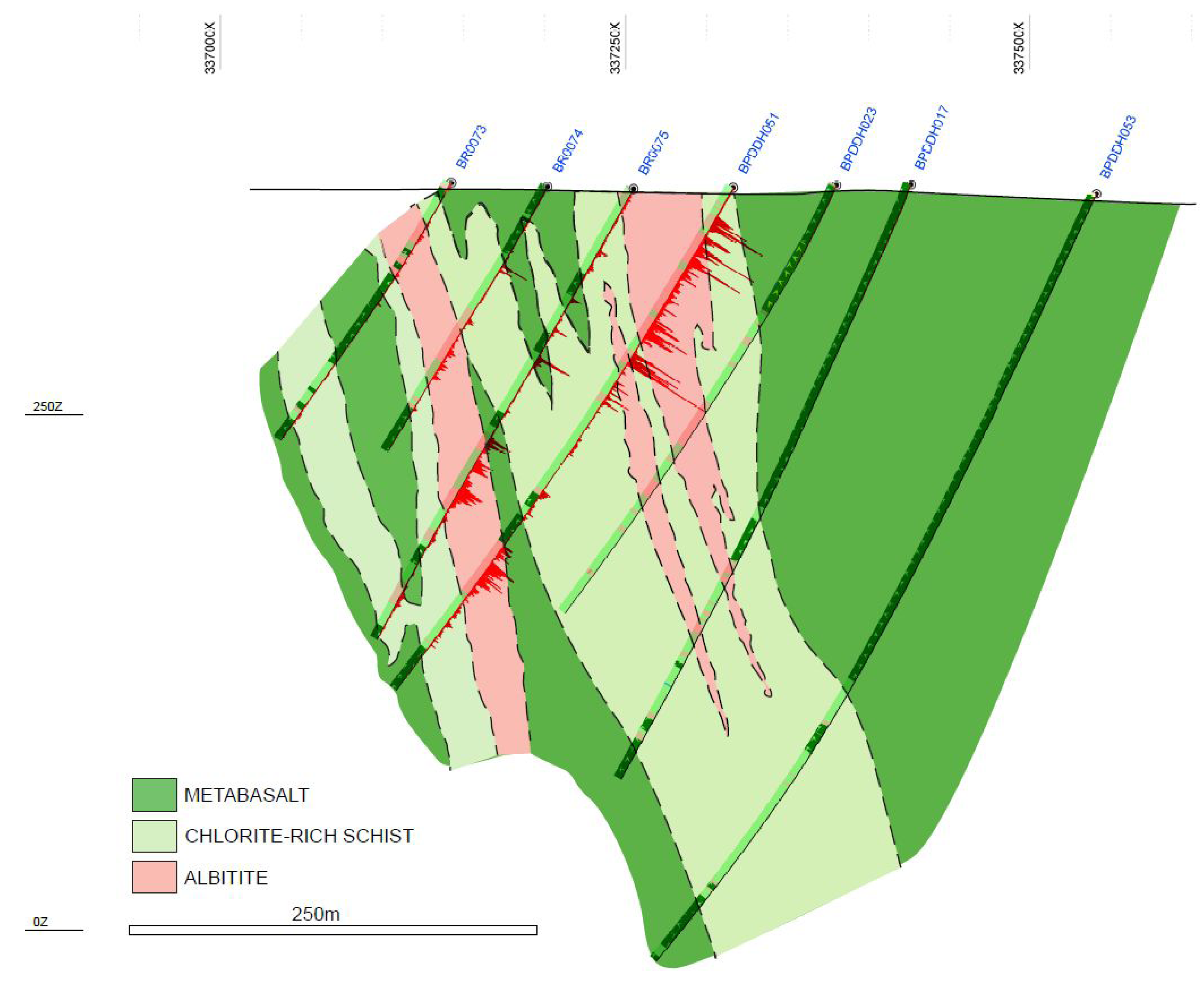
4. Bulk Chemistry and Mineralogy
4.1. Methods
4.2. Valhalla
| Oxide/Element | Meta-Basalt n = 16 | Meta-Sediment n = 12 | Chlorite-Carbonate Schist n = 21 | Albitite n = 41 | ||||||||
|---|---|---|---|---|---|---|---|---|---|---|---|---|
| % | Mean | Min | Max | Mean | Min | Max | Mean | Min | Max | Mean | Min | Max |
| SiO2 | 49.1 | 48.7 | 49.7 | 58.3 | 54.4 | 62.7 | 48.1 | 39.3 | 58.3 | 47.4 | 39.6 | 56.8 |
| TiO2 | 2.75 | 2.05 | 3.21 | 0.92 | 0.81 | 1.05 | 1.98 | 0.77 | 3.38 | 1.79 | 0.61 | 2.74 |
| Al2O3 | 12.6 | 11.9 | 13.5 | 13.7 | 9.1 | 18.0 | 13.6 | 10.2 | 17.5 | 10.3 | 5.4 | 14.5 |
| Fe2O3 | 16.8 | 15.2 | 17.7 | 7.7 | 5.2 | 10.2 | 13.3 | 8.0 | 18.4 | 13.0 | 7.8 | 20.2 |
| MgO | 4.39 | 3.54 | 5.62 | 2.86 | 1.75 | 3.25 | 3.86 | 3.18 | 5.16 | 3.87 | 2.34 | 6.69 |
| MnO | 0.20 | 0.16 | 0.25 | 0.08 | 0.05 | 0.14 | 0.14 | 0.06 | 0.25 | 0.14 | 0.05 | 0.24 |
| CaO | 7.58 | 5.62 | 8.51 | 5.06 | 1.64 | 10.90 | 6.38 | 1.38 | 11.65 | 7.15 | 3.22 | 11.95 |
| K2O | 1.23 | 0.08 | 1.93 | 3.75 | 2.05 | 5.65 | 1.70 | 0.07 | 6.15 | 0.13 | 0.01 | 0.96 |
| Na2O | 2.53 | 1.34 | 4.33 | 1.75 | 1.24 | 2.80 | 3.80 | 0.30 | 6.13 | 6.64 | 3.71 | 8.71 |
| P2O5 | 0.35 | 0.22 | 0.47 | 0.17 | 0.14 | 0.23 | 0.31 | 0.14 | 0.57 | 0.39 | 0.02 | 1.40 |
| LOI | 2.08 | 1.54 | 2.79 | 5.54 | 3.40 | 9.84 | 6.55 | 3.00 | 11.58 | 8.29 | 2.93 | 12.44 |
| Total | 99.76 | 99.59 | 99.97 | 99.92 | 99.72 | 100.05 | 99.79 | 99.51 | 100.05 | 99.01 | 94.26 | 99.99 |
| ppm | ||||||||||||
| Nb | 15.5 | 10.7 | 21.4 | 13.1 | 7.2 | 15.9 | 14.6 | 9.6 | 19.9 | 13.0 | 3.7 | 20.0 |
| Ta | 1.0 | 0.7 | 1.3 | 0.9 | 0.7 | 1.2 | 1.0 | 0.7 | 1.3 | |||
| Zr | 231 | 138 | 304 | 354 | 205 | 1,030 | 237 | 162 | 432 | 2,411 | 265 | >10,000 |
| Hf | 6.3 | 3.7 | 9.2 | 11.2 | 6.5 | 34.8 | 6.6 | 4.4 | 9.2 | 90.2 | 6.6 | 921.0 |
| Y | 51.9 | 32.1 | 68.3 | 29.4 | 23.1 | 35.1 | 44.1 | 26.9 | 63.1 | 51.6 | 14.8 | 132.0 |
| Th | 6.9 | 3.6 | 9.6 | 15.3 | 10.9 | 18.0 | 10.5 | 6.1 | 17.2 | 12.9 | 3.8 | 42.8 |
| U | 2.0 | 1.0 | 2.6 | 12.5 | 4.1 | 59.6 | 10.6 | 2.0 | 50.5 | 387.3 | 15.1 | >1,000 |
| V | 401 | 288 | 499 | 188 | 107 | 286 | 305 | 133 | 507 | 979 | 117 | 2780 |
| Cr | 84 | 30 | 160 | 68 | 40 | 80 | 67 | 30 | 110 | 55 | 30 | 80 |
| Co | 45.4 | 35.8 | 53.3 | 21.5 | 14.2 | 25.9 | 33.3 | 18.5 | 51.4 | 43.2 | 16 | 134.5 |
| Ni | 45 | 28 | 68 | 36 | 14 | 56 | 39 | 26 | 56 | 41 | 17 | 168 |
| Cu | 193 | 57 | 385 | 47 | 5 | 260 | 85 | 6 | 281 | 812 | 25 | 7110 |
| Zn | 148 | 91 | 176 | 86 | 59 | 101 | 104 | 50 | 162 | 66 | 25 | 140 |
| Pb | 7 | <5 | 14 | 10 | <5 | 17 | 10 | <5 | 19 | 124 | <5 | 657 |
| Ga | 22.8 | 18.5 | 25.9 | 20.9 | 13.8 | 27.3 | 22.4 | 13.6 | 28.4 | 16.2 | 12.1 | 24.8 |
| Rb | 50.7 | 3.1 | 92.1 | 200 | 106 | 300 | 79.9 | 1.1 | 269 | 4.7 | 0.5 | 52.8 |
| Cs | 2.51 | 0.21 | 6.05 | 4.88 | 2.65 | 7.8 | 2.27 | 0.11 | 6.73 | 0.29 | 0.01 | 4.19 |
| Sr | 134 | 105 | 185 | 76 | 47 | 127 | 133 | 24 | 238 | 275 | 55 | 525 |
| Ba | 303 | 30.4 | 536 | 535 | 290 | 762 | 320 | 7.9 | 1355 | 55.6 | 5.8 | 262 |
| La | 30.6 | 18 | 39.7 | 40 | 32 | 49.9 | 34.3 | 25 | 46.7 | 24.1 | 7.6 | 46.6 |
| Ce | 67.5 | 41.1 | 87 | 82.1 | 66.7 | 101 | 71.6 | 53.8 | 83.8 | 52.7 | 22 | 128.5 |
| Pr | 7.4 | 4.65 | 9.5 | 8.41 | 6.65 | 10.4 | 7.64 | 5.68 | 8.87 | 5.8 | 2.32 | 14.35 |
| Nd | 30.8 | 19.4 | 40.3 | 31.7 | 25.3 | 39 | 30.7 | 22.4 | 38 | 24.3 | 9.9 | 59.3 |
| Sm | 7.36 | 4.73 | 9.61 | 6.17 | 4.83 | 7.64 | 6.77 | 5 | 8.75 | 5.84 | 2.45 | 14.3 |
| Eu | 2.04 | 1.45 | 2.48 | 1.19 | 0.91 | 1.46 | 1.64 | 1.08 | 2.46 | 1.57 | 0.49 | 4.82 |
| Gd | 8.25 | 5.34 | 10.5 | 5.73 | 4.66 | 6.8 | 7.32 | 4.89 | 10.3 | 6.64 | 2.53 | 17.35 |
| Tb | 1.54 | 0.94 | 1.97 | 0.93 | 0.73 | 1.11 | 1.31 | 0.83 | 1.9 | 1.29 | 0.4 | 3.67 |
| Dy | 8.41 | 5.24 | 10.8 | 4.97 | 3.79 | 5.9 | 7.2 | 4.38 | 10.45 | 7.72 | 2.13 | 20.7 |
| Ho | 1.86 | 1.18 | 2.38 | 1.02 | 0.78 | 1.18 | 1.56 | 0.97 | 2.29 | 1.78 | 0.49 | 4.6 |
| Er | 5.13 | 3.18 | 6.66 | 3.01 | 2.38 | 3.42 | 4.36 | 2.72 | 6.36 | 5.59 | 1.61 | 14.65 |
| Tm | 0.76 | 0.47 | 1.21 | 0.46 | 0.35 | 0.54 | 0.65 | 0.43 | 0.93 | 0.93 | 0.26 | 2.54 |
| Yb | 5.04 | 3.09 | 6.67 | 2.9 | 2.36 | 3.45 | 4.34 | 2.83 | 6.14 | 6.82 | 1.87 | 19.45 |
| Lu | 0.72 | 0.44 | 0.93 | 0.43 | 0.39 | 0.51 | 0.62 | 0.39 | 0.87 | 1.03 | 0.26 | 3.19 |
| Density | 3.05 | 2.91 | 3.16 | 2.79 | 2.67 | 2.89 | 2.87 | 2.71 | 3.05 | 2.89 | 2.29 | 3.12 |
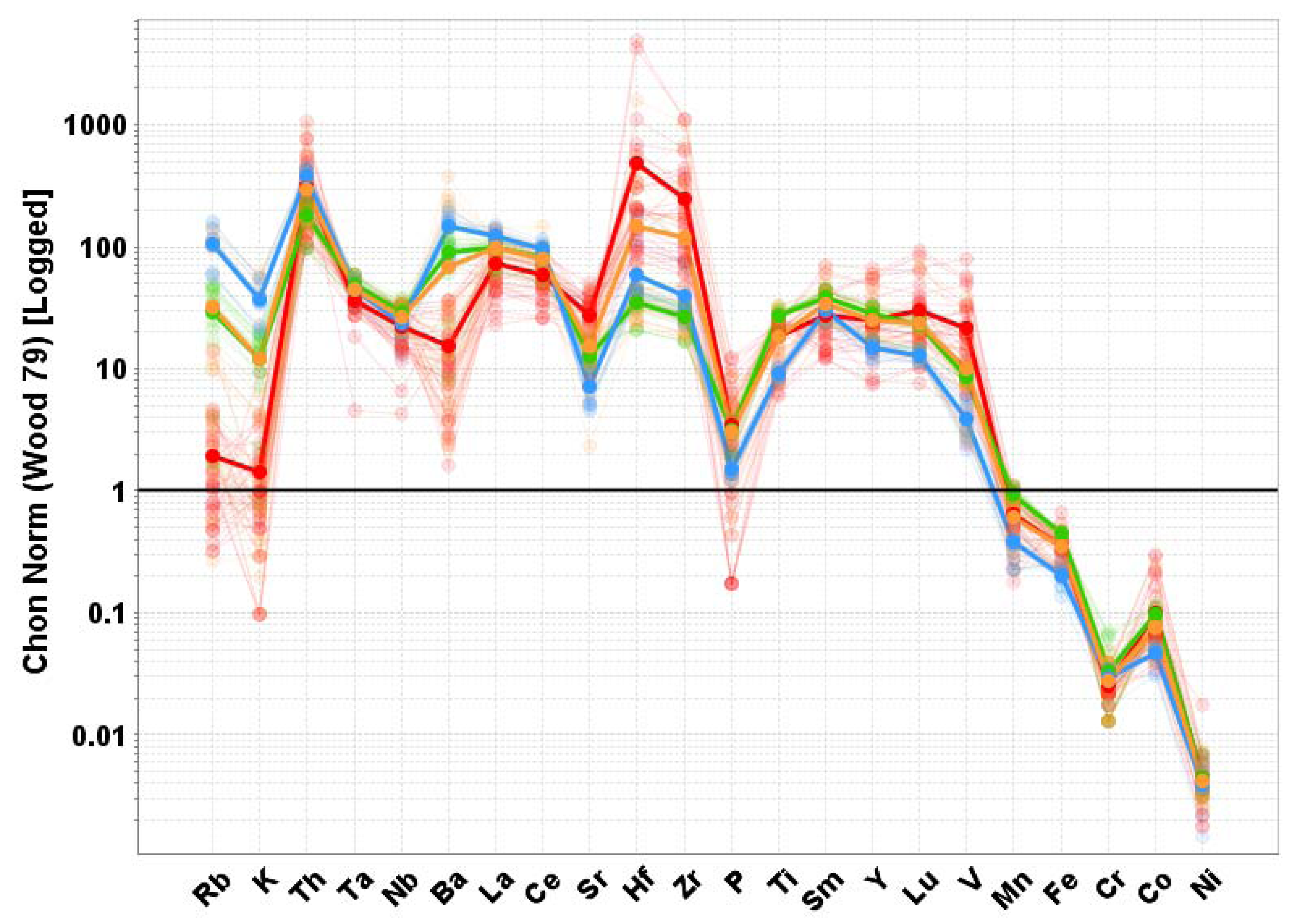
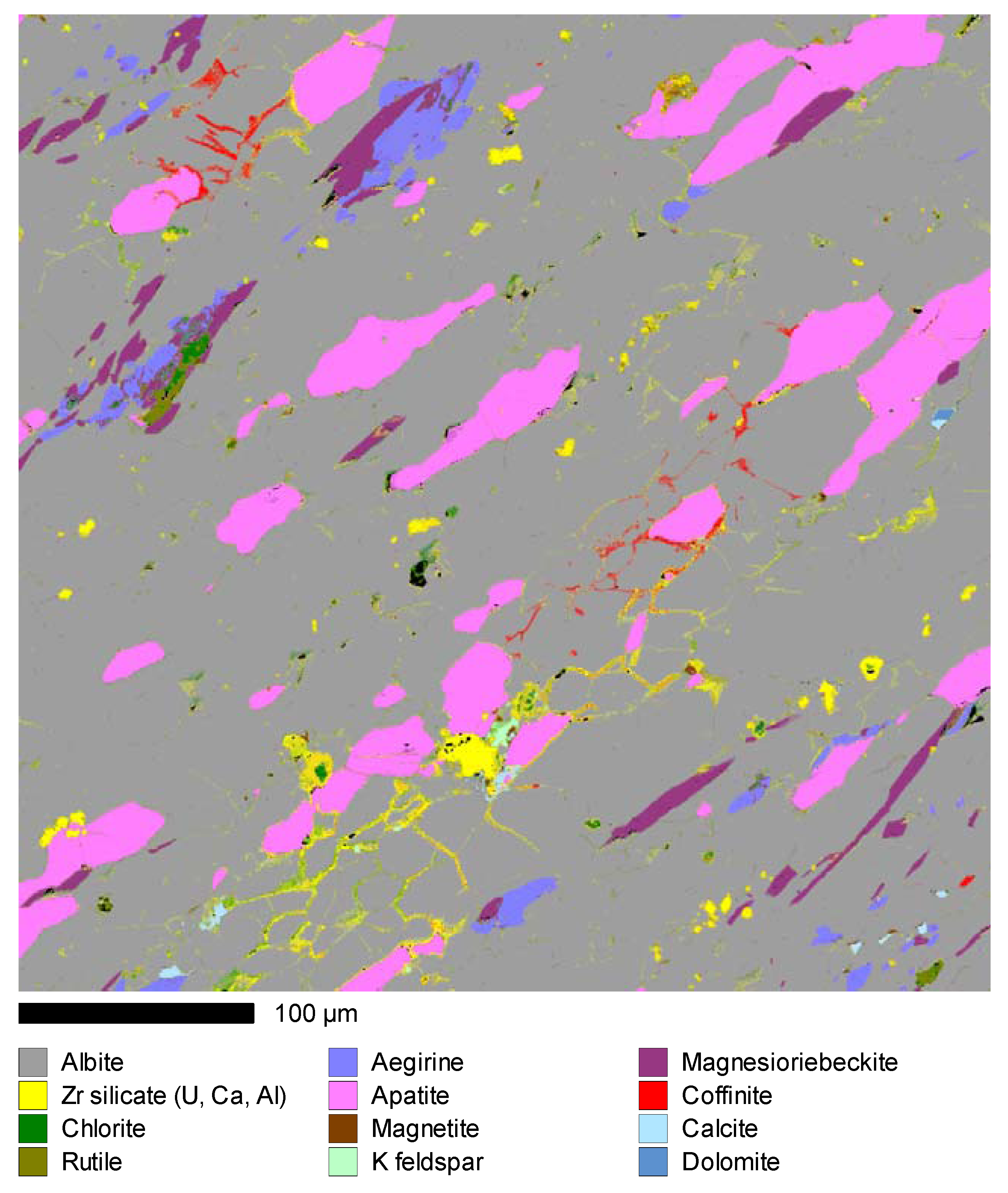
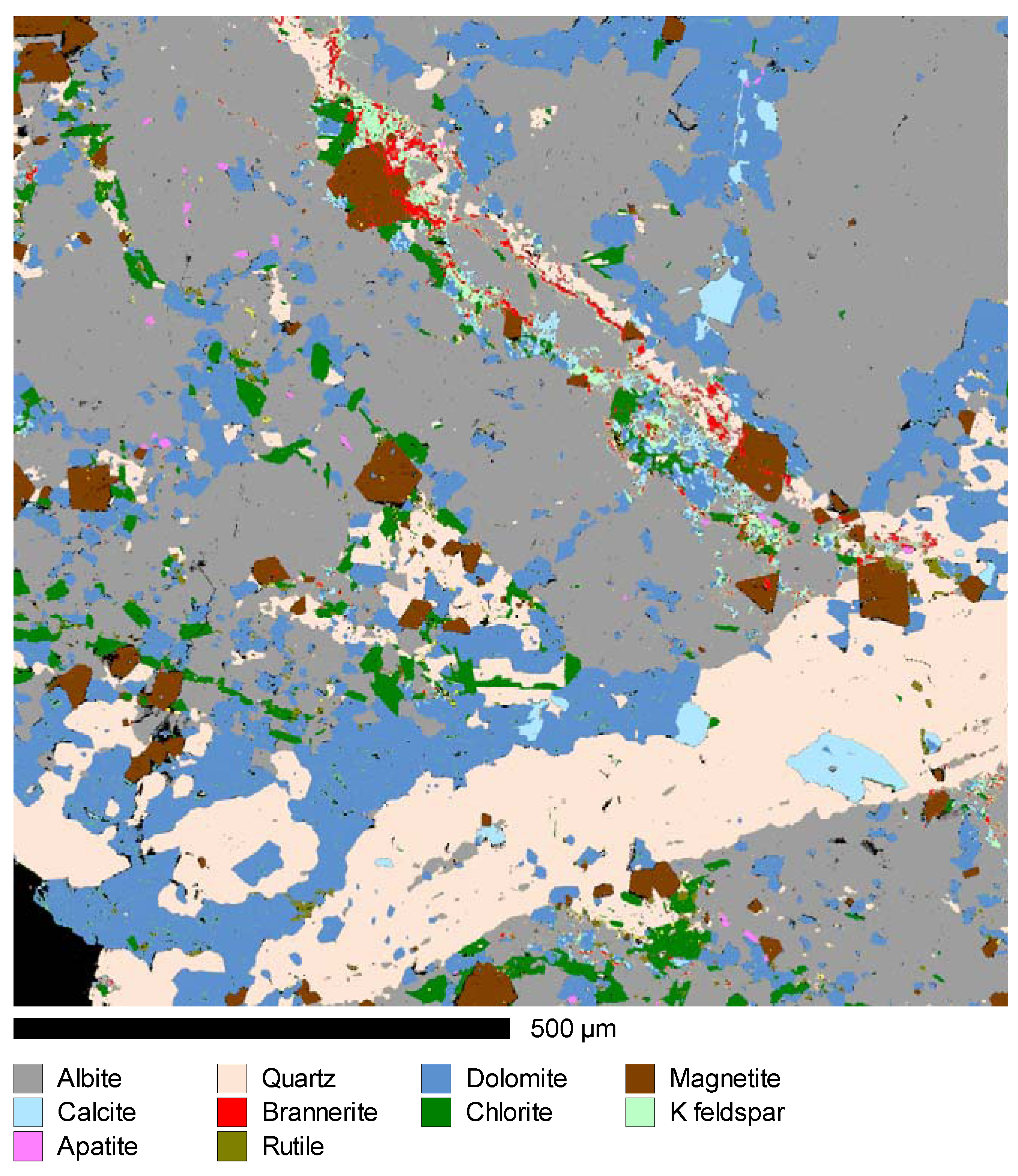
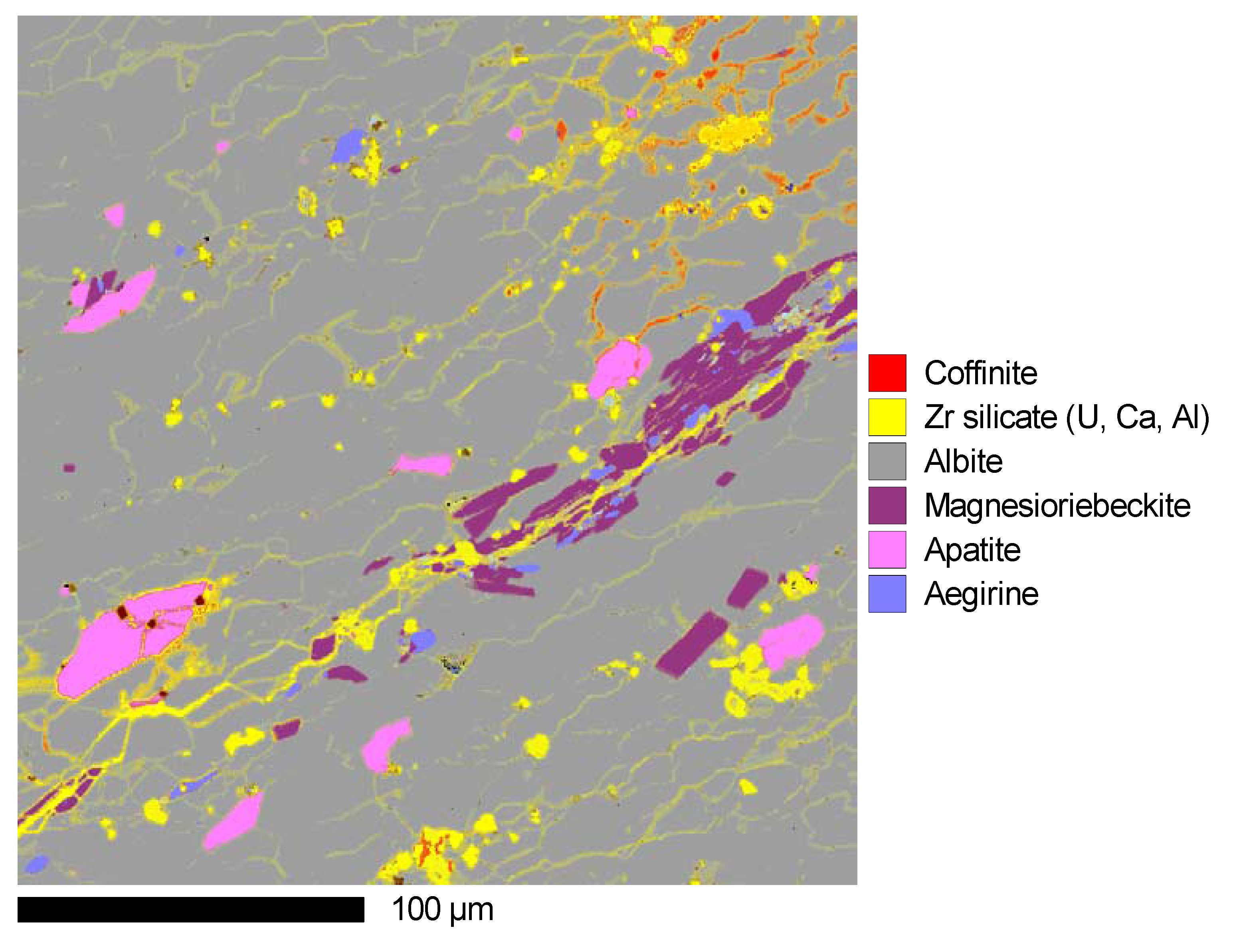
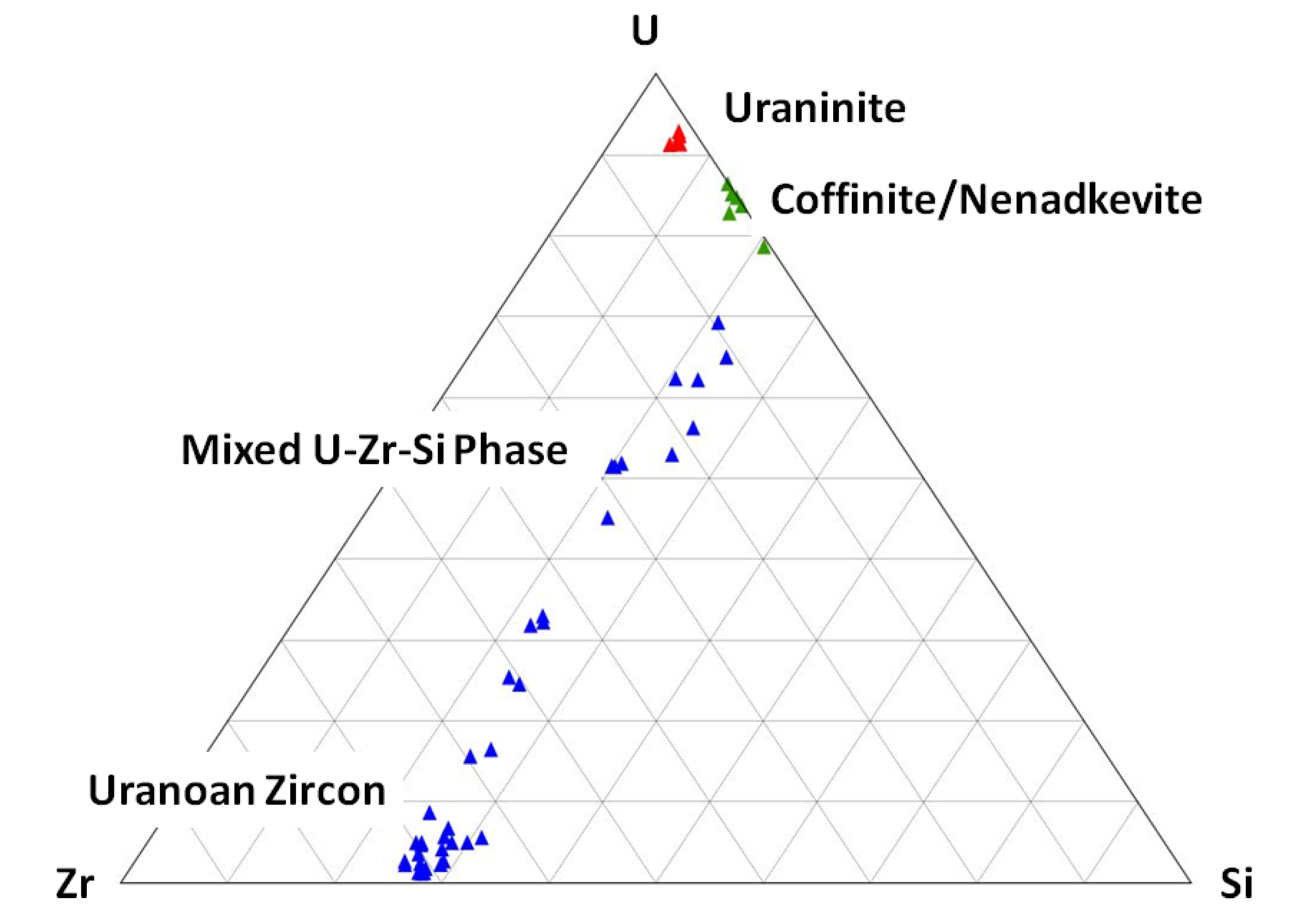
4.3. Skal Mineralogy and Paragenesis
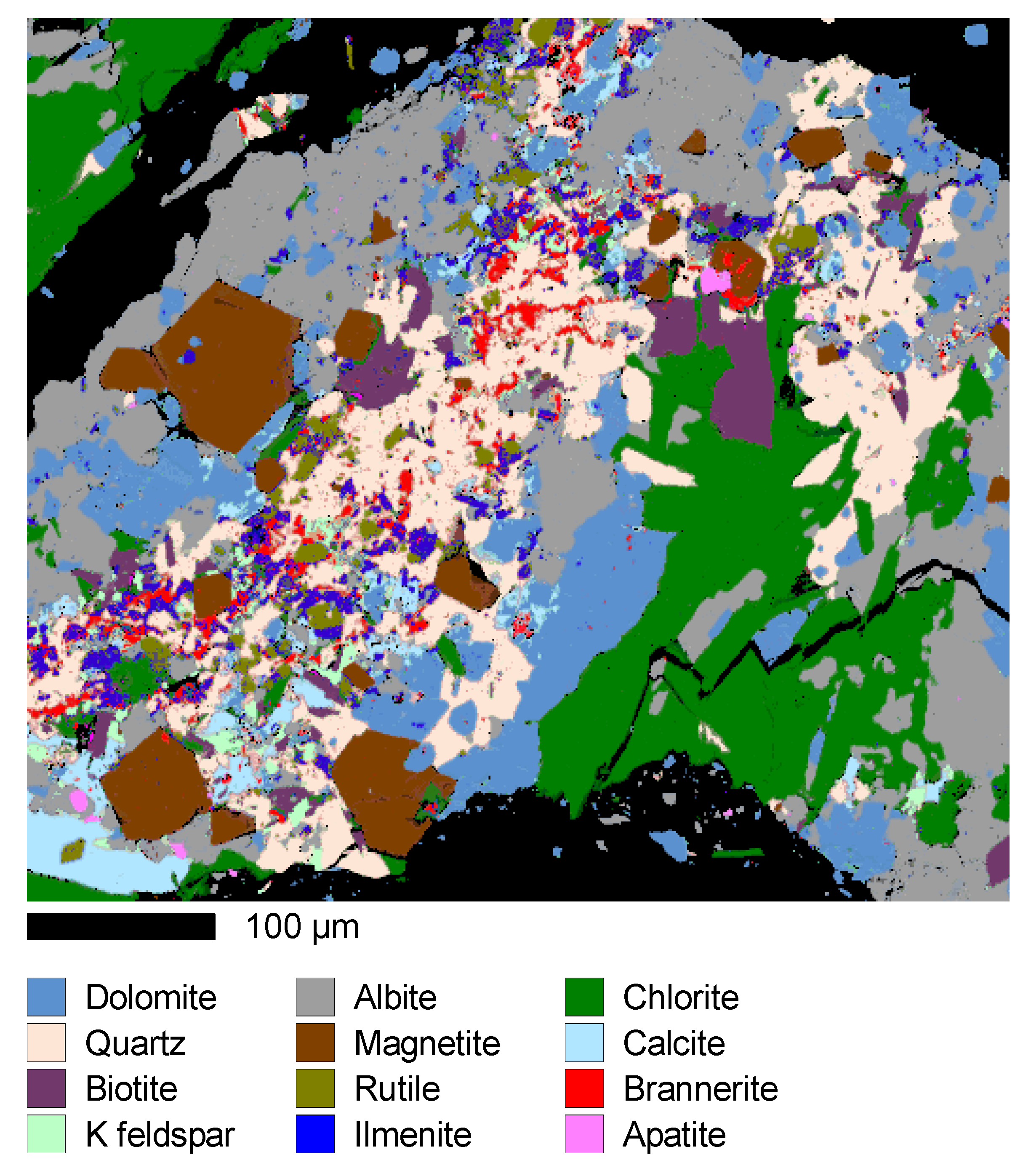
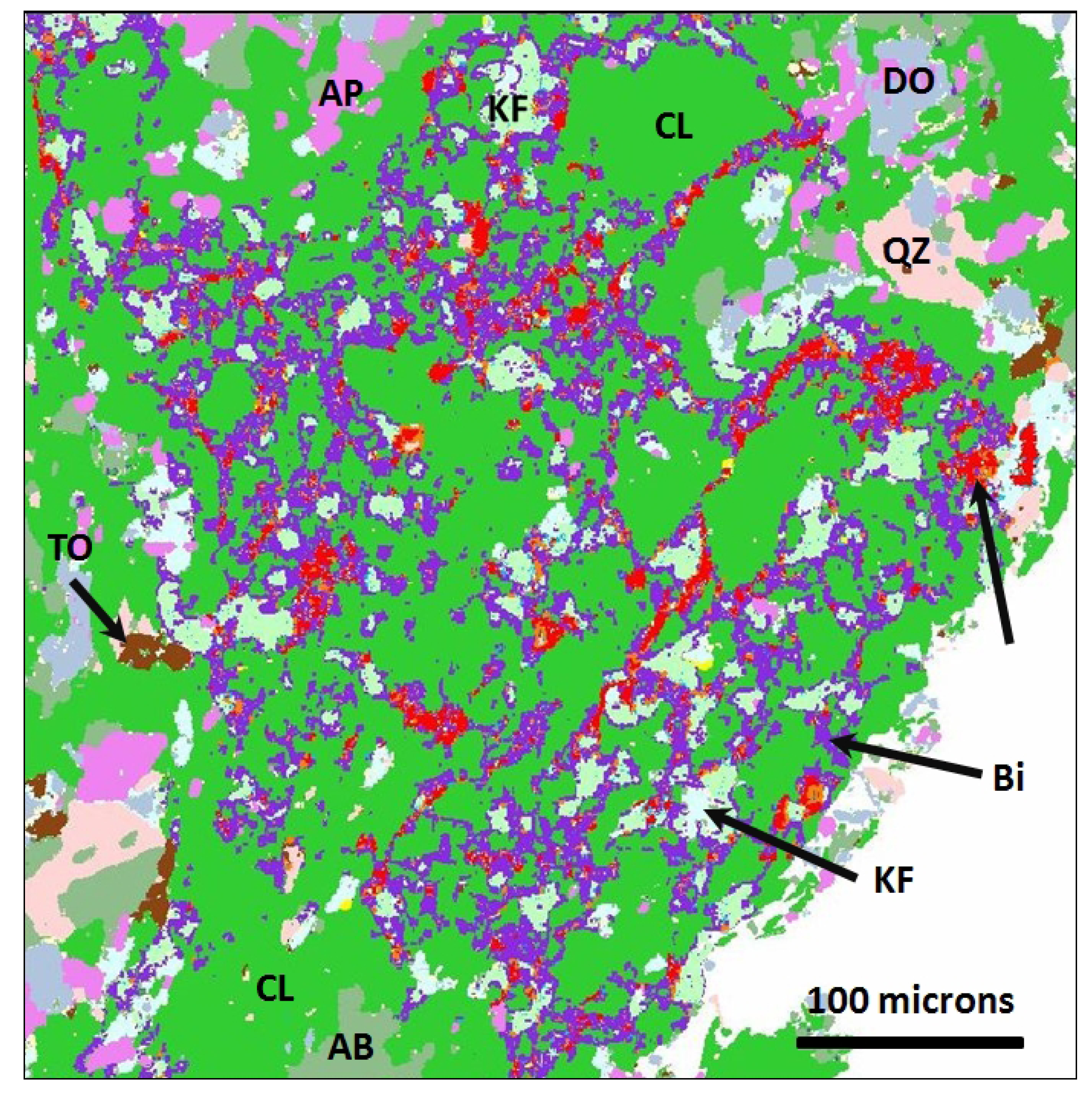
4.4. Bikini Mineralogy and Paragenesis
4.5. Other Deposits
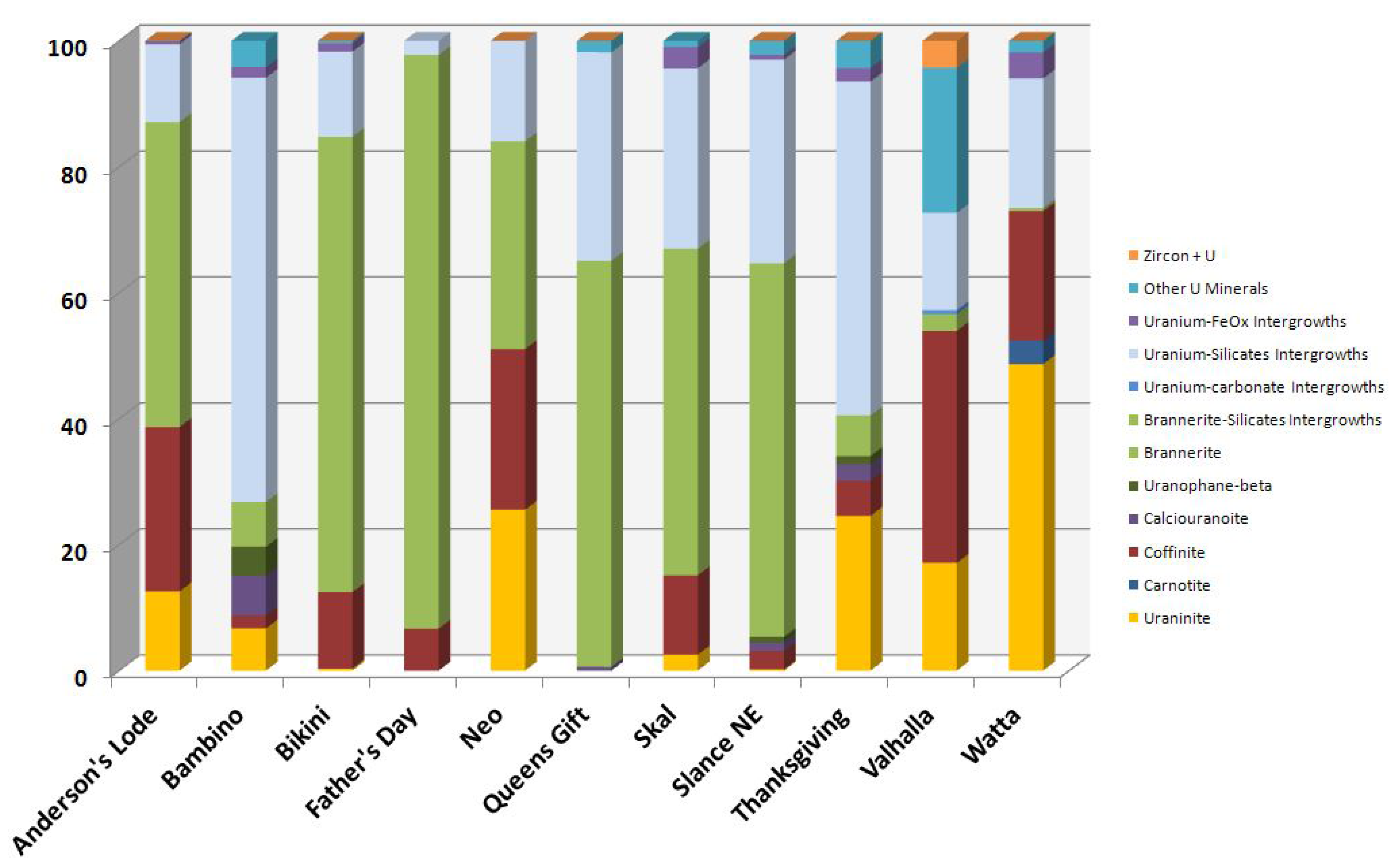
| Deposit | Sample # | U Minerals | Fe Oxides | Ti Oxides | Total Carbonate | Sulphides | Apatite | Quartz | Albite | K-feldspar | Zircon | Na-Pyroxene | Amphiboles | Micas | Chlorite |
|---|---|---|---|---|---|---|---|---|---|---|---|---|---|---|---|
| Anderson’s Lode | 9 | 2.5 | 3.4 | 1.2 | 11.3 | 0.1 | 18.7 | 18.0 | 13.9 | bld | 0.03 | nd | 2.4 | 14.0 | 10.3 |
| Bikini | 12 | 1.1 | 4.3 | 1.4 | 16.0 | 0.1 | 2.0 | 20.5 | 40.8 | 0.3 | 0.26 | 0.1 | 0.5 | 4.3 | 6.9 |
| Duke Batman | 2 | 0.2 | 4.6 | 1.3 | 25.3 | 0.2 | 6.1 | 19.4 | 20.5 | bld | 14.42 | 0.7 | 2.4 | 1.1 | 1.5 |
| Father’s Day | 1 | 0.0 | 1.6 | 1.9 | 46.1 | 0.0 | 35.0 | 10.6 | 0.4 | bld | bld | nd | 1.0 | 1.5 | 0.0 |
| Honeypot | 2 | 0.1 | 0.5 | 1.2 | 11.8 | 0.2 | 37.9 | 14.9 | 5.1 | bld | 7.98 | 0.5 | 2.9 | 1.4 | 6.1 |
| Neo | 1 | 0.0 | 0.0 | 0.3 | 4.4 | 0.0 | 52.5 | 8.1 | 20.5 | bld | 0.02 | nd | 2.6 | 6.9 | 2.9 |
| Skal | 15 | 0.7 | 3.4 | 2.4 | 15.0 | 1.0 | 5.1 | 29.9 | 24.8 | 0.3 | 0.24 | 0.1 | 2.1 | 3.5 | 10.4 |
| Valhalla | 19 | 1.6 | 3.6 | 4.3 | 8.9 | 1.3 | 7.8 | 6.0 | 41.4 | bld | 5.58 | nd | 13.4 | nd | 4.1 |
| Watta | 4 | 0.5 | 5.1 | 1.9 | 8.2 | 0.1 | 9.0 | 20.5 | 26.4 | bld | 4.77 | 0.1 | 1.1 | 15.1 | 3.9 |
| Average | 65 | 0.7 | 2.9 | 1.8 | 16.3 | 0.3 | 19.4 | 16.4 | 21.5 | 0.3 | 4.16 | 0.3 | 3.2 | 6.0 | 5.1 |
5. Discussion
5.1. Paragenesis and Timing
5.2. Comparison with Other Albitite-Type Deposits
5.3. Hydrothermal U-Zr Phase
5.4. An Evaluation of Published Genetic Models
6. Conclusions
Acknowledgements
Conflict of Interest
References
- Wilde, A.R. Towards a model for albitite-type uranium. Minerals 2013, 3, 36–48. [Google Scholar] [CrossRef]
- Goldney, L.H.; Canning, R.G.; Gooden, J.E.A. Extraction Investigations with Some Australian Uranium Ores; AAEC Symposium on Uranium Processing; Australian Atomic Energy Commission: Adelaide, Australia, 1972; pp. 1–18. [Google Scholar]
- Polito, P.; Kyser, K.; Stanley, C. The Proterozoic, albitite-hosted, Valhalla uranium deposit, Queensland, Australia: A description of the alteration assemblage associated with uranium mineralisation in diamond drill hole V39. Miner. Depos. 2007, 44, 11–40. [Google Scholar] [CrossRef]
- Gregory, M.; Wilde, A.; Jones, P. Uranium deposits of the Mount Isa region and their relationship to deformation metamorphism and copper deposition. Econ. Geol. 2005, 100, 537–546. [Google Scholar] [CrossRef]
- Wyborn, L. The Petrology and Geochemistry of Alteration Assemblages in the Eastern Creek Volcanics, as a Guide to Copper and Uranium Mobility Associated with Regional Metamorphism and Deformation, Mt Isa, Queensland. In Geochemistry and Mineralization of Proterozoic Volcanic Suites; GS Special Publication No. 33; Pharaoh, T.C., Beckinsale, R.D., Rickard, D., Eds.; Institute of Mining and Metallurgy: London, UK, 1987; pp. 425–434. [Google Scholar]
- Bain, J.H.C.; Heinrich, C.A.; Henderson, G.A.M. Stratigraphy, Structure and Metasomatism of the Haslingdon Group, East Moondarra Area, Mt Isa: A Deformed and Mineralised Proterozoic Multistage Rift-sag Sequence. In Detailed Studies of the Mount Isa Inlier; Australian Geological Survey Organisation Bulletin 243; Stewart, A.J., Blake, D.H., Eds.; Australian Geological Survey Organisation: Canberra, Australia, 1992; pp. 125–136. [Google Scholar]
- Perkins, C.; Heinrich, C.; Wyborn, L. 40Ar/39Ar geochronology of copper mineralization and regional alteration, Mount Isa, Australia. Econ. Geol. 1999, 94, 23–36. [Google Scholar] [CrossRef]
- Page, R. Chronology of magmatism, skarn formation, and uranium mineralization, Mary Kathleen, Queensland, Australia. Econ. Geol. 1983, 78, 838–853. [Google Scholar] [CrossRef]
- McGloin, M. U-Pb Shrimp geochronology of the Sybella microgranite: Is there a link to U-Ree prospects at Mount Isa? AIG News 2012, 110, 29–30. [Google Scholar]
- Gregory, M.J.; Schaefer, B.F.; Keays, R.R.; Wilde, A.R. Rhenium-Osmium systematics of the Mount Isa copper orebody and the Eastern Creek volcanics, Queensland: Implications for ore genesis. Miner. Depos. 2008, 43, 553–573. [Google Scholar] [CrossRef]
- Connors, K.A.; Page, R.W. Relationship between magmatism, metamorphism and deformation in the western Mount Isa Inlier, Australia. Precambrian Res. 1995, 71, 131–153. [Google Scholar] [CrossRef]
- Huang, W.; Rubenach, M. Structural controls on syntectonic metasomatic tremolite and tremolite-plagioclase pods in the Molanite Valley, Mt Isa, Australia. J. Struct. Geol. 1995, 17, 83–94. [Google Scholar] [CrossRef]
- Abu Sharib, A.S.; Sanislav, I.V. Polymetamorphism accompanied switching in horizontal shortening during Isan Orogeny: Example from the Eastern Fold Belt, Mount Isa Inlier, Australia. Tectonophys 2012, 587, 146–167. [Google Scholar] [CrossRef]
- Wilde, A.R. Mount Isa copper orebodies: Improving predictive discovery. Aust. J. Earth Sci. 2011, 58, 937–951. [Google Scholar] [CrossRef]
- Duncan, R.; Wilde, A.R.; Bassano, K.; Maas, R. Geochronological constraints on tourmaline formation in the Western Fold Belt of the Mount Isa Inlier, Australia: Evidence for large-scale metamorphism at 1.57 Ga? Precambrian Res. 2006, 146, 120–137. [Google Scholar] [CrossRef]
- Hannan, K.; Golding, S.D.; Herbert, H.K.; Krouse, H.R. Contrasting alteration assemblages in metabasites from Mount Isa, Queensland: Implications for copper ore genesis. Econ. Geol. 1993, 88, 1135–1175. [Google Scholar] [CrossRef]
- Heinrich, C.A.; Bain, J.H.C.; Mernagh, T.P.; Wyborn, L.A.I.; Andrew, A.S.; Waring, C.L. Fluid and mass transfer during metabasalt alteration and copper mineralization. Econ. Geol. 1995, 90, 705–730. [Google Scholar] [CrossRef]
- Oliver, N.H.S. Appraisal of Structural Geology and Controls on Mineralization in the Valhalla Region, 2010; 30, Unpublished Report to Summit Resources, Holcombe Coughlin Oliver Consultants.
- Oliver, N.H.S. Appraisal of Structural Geology and Controls on Mineralization in the Valhalla Region (Part 2), 2010; 30, Unpublished Report to Summit Resources, Holcombe Coughlin Oliver Consultants.
- Oliver, N.H.S. Prospectivity, Structure and Geochemistry in the Valhalla District, 2010; 19, Unpublished Report to Summit Resources, Holcombe Coughlin Oliver Consultants.
- Werth, C. Petrography and Geochemistry of the Duke Batman Uranium Deposit in Northwestern Queensland, Australia. Master’s Thesis, RWTH Aachen University, Aachen, Germany, 10 September 2012. [Google Scholar]
- Anonymous. QEMSCAN Analysis Valhalla Uranium Thin Sections, 2009; Unpublished AMDEL Report N3437QS09.
- De Nooy, D.; Hodgson, W. Mineralogical Investigation of Twenty Polished Thin Sections Using QEMSCAN and SEM-EDS Methods; 2010; Job NO: S0591; SGS Report to Summit Resources. [Google Scholar]
- Hodgson, W.; de Nooy, D.; Lonsdale, G. Mineralogical Investigation of Ten Polished Thin Sections Using QEMSCAN and SEM-EDS Methods; 2009; SGS Report to Summit Resources. [Google Scholar]
- Armstrong, J.T. CITZAF: A package of correction programs for the quantitative electron microbeam X-ray-analysis of thick polished materials, thin films, and particles. Microbeam Anal. 1995, 4, 177–200. [Google Scholar]
- Harrowfield, I.R.; MacRae, C.M.; Wilson, N.C. Chemical Imaging in Electron Microprobes. In Proceedings of the 27th Microbeam Analysis Society Annual MAS Meeting, New York, NY, USA, 1993; pp. 547–548.
- Wood, D.A.; Joron, J.L.; Treuil, M.; Norry, M.; Tarney, J. Elemental and Sr isotope variations in Basic Lavas from Iceland and the surrounding ocean floor. Contrib. Miner. Petrol. 1979, 70, 319–339. [Google Scholar] [CrossRef]
- Lumpkin, G.R.; Leung, S.H.F.; Colella, M. Position, Geochemical Alteration, and Alpha-Decay Damage Effects of Natural Brannerite. In Proceedings of 23th International Symposium on Scientific Basis for Nuclear Waste Management, Boston, MA, USA, 29 November–2 December 1999; pp. 359–365.
- Polikarpova, V.A. Nenadkevite—A new silicate of uranium. J. Nucl. Energy 1957, 4, 262–265. [Google Scholar]
- Alexandre, P. Mineralogy and geochemistry of the sodium metasomatism-related uranium occurrence of Aricheng South, Guyana. Miner. Depos. 2009, 45, 351–367. [Google Scholar] [CrossRef]
- Cinelu, S.; Cuney, M. Sodic metasomatism and U–Zr mineralization: A model based on the Kurupung batholith (Guyana). Goldschm. Conf. Abstr. 2006, 70, A103. [Google Scholar]
- Omel’yanenko, B.I.; Mineyeva, I.G. Pre- and Syn-Ore vertical zonation in Precambrian uraniferous sodic metasomatites. Int. Geol. Rev. 1982, 24, 422–430. [Google Scholar] [CrossRef]
- Helean, K.B.; Burakov, B.E.; Anderson, E.B.; Strykanova, E.E.; Ushakov, S.V.; Ewing, R.C. Mineralogical and microtextural characterization of “gel-zircon” from the Manibay uranium mine, Kazakhstan. Mat. Res. Soc. Symp. Proc. 1997, 465, 1219–1226. [Google Scholar]
- Zhukova, V.Y. Mineralogy and Primary Zoning of Hydrothermal Metasomatic Uranium Deposits in Precambrian Iron Formations. In Albitized Uranium Deposits: Six Articles Translated from Russian Literature; Report GJBX-193; Avrashov, A., Abou-Zied, S., Kerns, G., Eds.; U.S. Department of Energy: Washington, DC, USA, 1980; pp. 91–112. [Google Scholar]
- Cuney, M.; Emetz, A.; Mercadier, J.; Mykchaylov, V.; Shunko, V.; Yuslenko, A. Uranium deposits associated with Na-metasomatism from central Ukraine: A review of some of the major deposits and genetic constraints. Ore Geol. Rev. 2013, 44, 82–106. [Google Scholar]
- Sheard, E.; Williams-Jones, A.; Heiligmann, M.; Pederson, C.; Trueman, D. Controls on the concentration of zirconium, niobium and the rare earth elements in the Thor Lake rare metal deposit, Northwest Territories, Canada. Econ. Geol. 2012, 107, 81–104. [Google Scholar] [CrossRef]
- Guimaraes, D. The Zr Ore deposits of the Pocos de Caldas Plateau, Brazil and Zr chemistry. Bol. Inst. Tecn. Ind. Minas Gerais 1948, 6, 1–40. [Google Scholar]
- Kuschke, O.; Tonking, M. Geology and mining operations at Palabora Mining Company Ltd, Phalaborwa, NE Transvaal. J. South Afr. Inst. Min. Met. 1971, 72, 12–22. [Google Scholar]
- Aja, S.U.; Wood, S.A.; Williams-Jones, A.E. The aqueous geochemistry of Zr and the solubility of some Zr-bearing minerals. Appl. Geochem. 1995, 10, 603–620. [Google Scholar] [CrossRef]
- Migdisov, A. The solubility of Zr in F-bearing hydrothermal solutions. Geochim. Cosmochim. Acta 2009, 73, A879. [Google Scholar] [CrossRef]
- Chambefort, I.; Kamenetsky, V.; McPhie, J.; Bath, A.; Agangi, A.; Allen, S.R.; Ehrig, K.; Green, N. The Olympic Dam Cu-Au-U Deposit, South Australia: Was Fluorine a Key in Forming this Giant? In Proceedings of the Tenth Biennial SGA Meeting, Townsville, Austrlia, 2009; pp. 207–209.
© 2013 by the authors; licensee MDPI, Basel, Switzerland. This article is an open access article distributed under the terms and conditions of the Creative Commons Attribution license (http://creativecommons.org/licenses/by/3.0/).
Share and Cite
Wilde, A.; Otto, A.; Jory, J.; MacRae, C.; Pownceby, M.; Wilson, N.; Torpy, A. Geology and Mineralogy of Uranium Deposits from Mount Isa, Australia: Implications for Albitite Uranium Deposit Models. Minerals 2013, 3, 258-283. https://doi.org/10.3390/min3030258
Wilde A, Otto A, Jory J, MacRae C, Pownceby M, Wilson N, Torpy A. Geology and Mineralogy of Uranium Deposits from Mount Isa, Australia: Implications for Albitite Uranium Deposit Models. Minerals. 2013; 3(3):258-283. https://doi.org/10.3390/min3030258
Chicago/Turabian StyleWilde, Andy, Alex Otto, John Jory, Colin MacRae, Mark Pownceby, Nick Wilson, and Aaron Torpy. 2013. "Geology and Mineralogy of Uranium Deposits from Mount Isa, Australia: Implications for Albitite Uranium Deposit Models" Minerals 3, no. 3: 258-283. https://doi.org/10.3390/min3030258
APA StyleWilde, A., Otto, A., Jory, J., MacRae, C., Pownceby, M., Wilson, N., & Torpy, A. (2013). Geology and Mineralogy of Uranium Deposits from Mount Isa, Australia: Implications for Albitite Uranium Deposit Models. Minerals, 3(3), 258-283. https://doi.org/10.3390/min3030258





